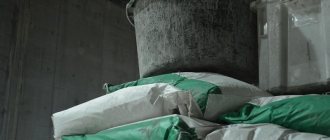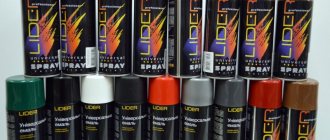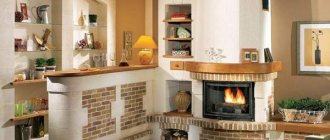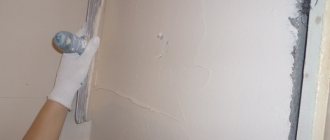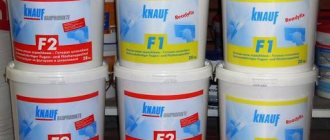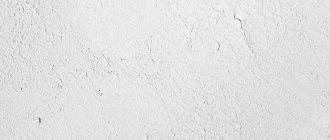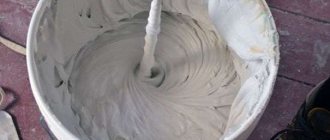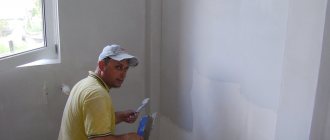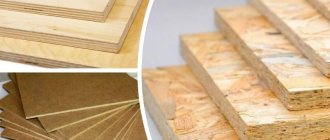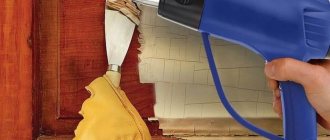Features of PVA-based putty
PVA putty is produced in accordance with GOST 520-20 from 2003. This product is based on polyvinyl acetate, which acts as a binder and is part of the glue of the same name. PVA is environmentally friendly and provides a high degree of adhesion to various substrates. Since polyvinyl acetate is easily diluted with water and is suitable for many construction works, the putty is considered universal and multifunctional.
Composition and technical characteristics
In addition to PVA, the putty also contains other components. Chalk is used as a filler, and some manufacturers also add talc to the product, since it has the finest fraction and helps to give the mass evenness without bubbles and potholes. Other components of the putty are:
- carboxymethylcellulose (CMC) and other plasticizers - to increase softness and reduce the effort required to grind treated surfaces;
- latex - to prevent cracking of the putty layer after drying and during the entire service life;
- antiseptics and special additives - to protect surfaces from fungus, mold, and prevent insect infestation;
- drying oil - to give the solution elasticity and for more convenient application;
- emulsifiers and preservatives - to prevent deterioration of the composition and increase shelf life.
Typically, PVA putty is sold ready-made, since only in a diluted form it meets the requirements of GOST, and when diluted independently it can acquire other technical parameters. Dry building mixtures based on PVA are often sold in large volumes and used in industry.
The product characteristics are:
- high adhesive force (up to 450 N/m);
- guaranteed adhesion to basic building materials;
- no shrinkage, detachment, cracking;
- ensuring a smooth surface;
- ease of application;
- non-toxic, completely safe for humans;
- high drying speed - up to a day.
PVA glue as a basis for a universal finishing material
My friend Vadik and I each have several lonely aunties, whom we help whenever possible. At the dachas, they did the repairs themselves and as they saw fit. It's time to tidy up your city apartments. Therefore, there was no need to be bored. All work was carried out under the lessons of economy and proper use of materials.
Wall putty
It was useless to resist, and we widely used:
- polyvinyl acetate emulsion - PVA glue;
- chalk;
- talc;
- carboxymethylcellulose is the dry base of CMC wallpaper glue.
All components were cheap, dissolved in water and were freely sold in stores or stored on mezzanines since the “old” times. Don't be surprised by the complex chemical names of commonly known substances. One of the aunts was a chemist and taught the others.
PVA-based putty is universal and can be applied to almost any material. Otherwise, the surface is primed with PVA glue diluted in half with water, and adhesion is ensured both with the wall and with the paint applied on top.
When creating the finishing putty, PVA serves as the base. Chalk is used as a filler. It is not necessary to pour talc, but it has a fine fraction and contributes to the formation of a smoother surface. CMC is used as a plasticizer, it makes the putty soft and, after hardening, it can be sanded with less effort.
During the industrial production of putty, protective substances are added that repel rodents and insects, repel dust and bind the soluble components of the mixture, making it resistant to moisture. Additional latex-based plasticizers prevent cracking.
Purpose and scope
Typically, PVA putty is used for finishing bases made of concrete, brick, wood, foam blocks, cinder blocks and other popular building materials. The product is suitable for treating previously plastered bases or walls covered with a basic building mixture. After puttying with a PVA-based product, the following can be applied to the surface:
- water-based paint;
- latex paint;
- lime whitewash;
- oil paints and emulsions;
- adhesive compositions.
PVA putty is considered the most suitable for interior work in rooms with low and medium humidity. It is not suitable for the bathroom, kitchen and other rooms where the humidity level is too high.
Disadvantages of PVA putty and errors in application
It is necessary to take into account several disadvantages of putties containing polyvinyl acetate glue, they are:
- Not suitable for external objects exposed to natural factors;
- Not suitable for treating rooms with high humidity;
- Cannot cope with deep defects;
- They cannot serve as a base for tiles.
Common mistakes:
- Applying the mixture to the surface in a layer that is too thick. This cannot be done, as it will begin to slide under its own weight;
- Insufficient drying time for the first layer. Before applying the next layers, it is necessary to dry the previous ones for at least three hours, otherwise it will be smeared under the spatula.
In general, PVA-based putty is a pleasant to use, effective and obedient technical building material.
Before applying subsequent layers, it is necessary to dry the previous ones for at least three hours.
Advantages and disadvantages
The product has a lot of advantages, which is why it is very popular among professionals and beginners in repair work. The material has a natural composition, which includes natural components and harmless synthetic additives. During drying and during use, the putty does not emit any odor, so it can even be used in children's rooms, gardens and hospitals.
After puttying, the walls will be resistant to the development of fungus and the colonization of microorganisms. As the putty is applied, the surface becomes snow-white, neutral in tone to any type of subsequent finishing - it can be painted even with the lightest paints. Other advantages of PVA-based material:
- low consumption (up to 0.5-1 kg/square meter);
- low price;
- evenness, perfect smoothness of the dried layer;
- ease of use and quick drying;
- resistance to temperature fluctuations;
- long shelf life;
- strength and non-shrinkage.
PVA putty also has its disadvantages. It is highly hygroscopic, therefore it is absolutely not suitable for wet rooms and outdoor work. Manufacturers also do not recommend applying the material under ceramic tiles and for leveling walls with large differences - for this purpose it is necessary to use more durable cement-based compounds.
Choosing putty for walls
You can buy PVA-based putty at any hardware store. It is sold in different packaging: cans of 0.5 and 3 kg, buckets of 10–15 kg, so you can roughly calculate the consumption and buy the right amount of product. You should not take the material that is sold in street kiosks during the cold season - after freezing the composition becomes inapplicable! Also, when purchasing, it is important to pay attention to the expiration date: it must be normal. It is better to give preference to a well-known brand, even if the price of the product is higher.
Advantages of a simple composition
Wall finishing with putty
PVA-based putty, universal for use, has many advantages:
- low cost;
- naturalness;
- does not contain harmful substances;
- faint odor disappears as it dries;
- does not require special work skills;
- smooth surface and white color;
- high adhesion;
- availability of self-production.
The popularity of putty created on the basis of PVA lies in its versatility. There is no need to buy separate compounds for different surfaces. It is stored dry for a long time without access to air, or rather moisture. Suitable for finishing most building materials:
- tree;
- brick;
- aerated concrete;
- Styrofoam;
- drywall;
- Chipboard and MDF;
- plaster on various bases;
- paint, including oil paint.
Related article: DIY decorative fence
When prepared, the putty, due to the dispersed state of PVA, forms a homogeneous mass, suitable for 12 hours when stored in a closed container. There is no need to stir it further. The finished putty does not settle and does not delaminate.
Manufacturers of putties
Among the variety of ready-made putty mixtures, those produced by popular brands and the most popular among craftsmen stand out.
Cork-S
This company occupies a leading position in the building mixtures market in the Russian Federation. It produces several lines of various putties, including those based on PVA. Such products can be used both for treating large areas and for repairing cracks, chips, and individual defects. PVA putty of this brand is sold in buckets of 3 and 15 kg.
"Areal+"
The company produces putties in Russia based on high quality foreign raw materials. PVA mixtures provide a perfectly smooth surface, have a snow-white color, are completely odorless and have a high degree of plasticity. They are packaged in cans of 1.5, 3, 15 kg, and are also presented on the market in dry form in industrial packaging.
"Diola"
Another large manufacturer of building mixtures, using only high-quality imported raw materials. This brand of polyvinyl acetate-based putty is used for finishing ceilings and walls, including before wallpapering and painting.
Making your own mixture for smooth leveling before painting
Our aunties brought us chalk and CMC. Vadik and I bought PVA glue ourselves. Instead of talc, we were provided with baby powder. Then we explained that the quality of putty is influenced not only by the proportional amount of components, but also by the quality of chalk grinding, the purity of talc and others. Therefore, we forced our aunties to calculate for us the ratio of these components to obtain a mixture with the given characteristics:
- density;
- viscosity;
- plastic.
PVA based putty
We putty the walls with our own hands
In addition to the main substances, ready-made putties contain various plasticizers, antiseptics and a number of other components. All additives improve the quality of the material. The cost in the store is slightly higher than homemade putty.
Self-production of material
If desired, you can easily make the putty mixture yourself. All components for it are sold in construction and hardware stores. You will need:
- PVA (glue) - 1 part;
- chalk (talc, baby powder, sawdust dust, dry gypsum plaster - to choose from) - 2.5 parts;
- plasticizer (dry wallpaper glue or glycerin, drying oil) - 0.05 parts.
As a plasticizer, some introduce casein glue, liquid or grated laundry soap, but with drying oil the smoothness of the composition is the highest. The addition of this component cannot be ignored, otherwise working with putty will be labor-intensive. First, the dry ingredients are mixed together, then they are diluted with PVA, after which other liquid ingredients are added to the mass.
You need to make sure that the homemade putty resembles thick sour cream, since a too liquid product will go on unevenly, with sagging. Sawdust is added if the mass is planned to be used to seal cracks, and for finishing puttying of walls it is better to add white components to the composition.
Mode of application
PVA putty is applied over the base plaster. It is not applied as a thick leveling layer - only gypsum and cement products are suitable for this. It is advisable to carry out work at a temperature of +20…+30 degrees.
Preparing the base
The better the wall or ceiling is prepared, the less material is consumed and the more even the surface is. Usually the bases are leveled with base plasters, removing all significant defects and differences. Next, the walls are cleaned of dirt, dust and primed. If required, degrease with solvents (usually for substrates that have not been plastered).
You cannot ignore priming the walls and ceiling - this stage helps to increase the adhesion between the putty and the plaster, and increase the service life of the finished coating. The primer is applied with a brush or roller in 2–3 layers. Each subsequent layer is performed only after the previous one has dried.
Applying putty
In addition to the PVA plaster itself, polyurethane grout and primer, the following equipment will be required for work:
- two spatulas - wide and narrow;
- mounting gun and sealant (if you need to seal deep cracks);
- masking tape;
- polyethylene film.
When working with finishing plaster, only clean spatulas can be used - even a small piece of dried material will leave stripes and dents on the wall. Before applying the putty, cover the floor and cover doors and window openings with masking tape. Deep cracks are widened, cleaned out with the sharp end of a spatula, and then sealed with sealant.
The PVA mixture is thoroughly mixed to prevent separation of the components. First, spread the mass over a wide spatula using a narrow spatula, after which the composition is applied to the surface with sweeping movements. The layer thickness should be up to 0.5-1 mm, no more. After drying (after 2–3 hours), treat the walls and ceiling with polyurethane grout, and then after 24 hours with a primer. The surface will be completely dry in another day, and then you can glue wallpaper on it or paint it according to the user’s idea.
